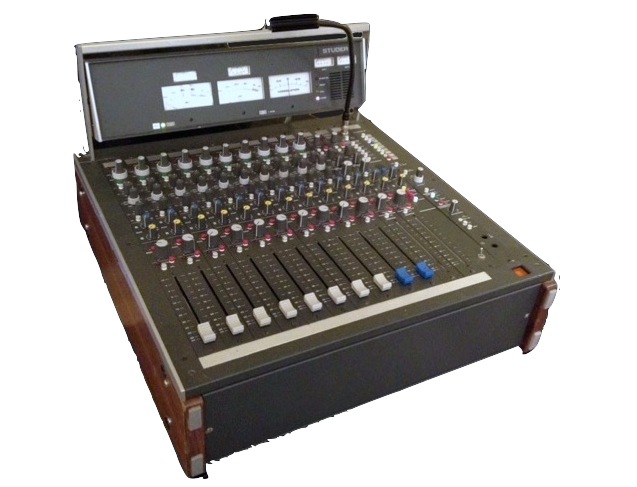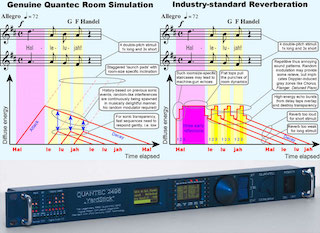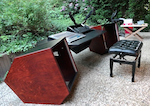Studio Hardware & Setup
I consider the fact that we can work with such high-quality equipment today to be a major social step forward: whereas in the past, the highest quality was only available through institutions, expensive studios, or millionaires—meaning you had to “knock on doors,” pass tests, and bend over backwards—today it has become accessible to everyone. What's more, it can be stored in just a few boxes—rather than spread across several floors.

The redesign of the Mobile Studio 2025/26
Between 2015 and 2025, I had set up my studio in such a way that I could easily compare analog and digital processes at the touch of a button. To do this, I also purchased several additional analog processors. I wanted to catch up on what I had neglected during my 10 years (1993 to 2003) in the electronic studio at the Basel Academy of Music (sound engineering), because at that time I was mainly focused on DSP and interface programming, which was advancing very rapidly and bringing about substantial changes. Over the course of 2025, I gradually scaled back the studio (without any regret) to the core instruments and am now devoting myself to my ideas again and do what I had planned to do for a long time, but which was not technically possible ten years ago. Now it's finally become possible. I'm happy to have less stuff and more musical creativity in my significantly simplified and better structured studio setup (and now even more “Mobile”-).
My hardware has to fulfil many different tasks: it's an electronic instrument, a live (stage) mixer and recording equipment, multi-channel capable, but also optimized for daily use (still stereo), a production studio, from mixing to mastering in audiophile quality. Small size and weight, as well as simple setup and take-down, are to ensure mobility.
My preferred operating frequency is 96kHz/24Bit. The perceptible difference in sound in terms of kilohertz occurs at around 90kHz, so the difference between 44.1 (CD) and 96 kHz is more noticeable than the difference between 96 and 192 kHz, which is more likely to be detected only with top-of-the-line equipment in a studio setting. The step from 96 to 192 kHz, on the other hand, is particularly noticeable in “real time,” as latency is halved once again.
// Explanation: Since the sample rate refers to the measured samples per second, it can be considered the “speed” when it comes to real-time applications. //
The outline of my Hardware & Setup page:
- Audio Interfaces, Mic Preamps, Accessories
- Analog Post-Production - Consoles and Outboard Gear
- PlugIns
- Utility
- Monitors, PA, Combo-Amp
Audio Interfaces
Metric Halo ULN-8 and LIO-8


 Metric Halo ULN-8 and LIO-8 are top-class audio interfaces and the centrepiece of my studio. ULN-8 and LIO-8 are technical twins, however, the LIO-8 does not come with mic preamps, but can be retrofitted with two circuit boards (each with 4 mic preamps) and will then be identical to the ULN-8. The circuit boards can be installed without prior technical knowledge. My LIO-8 is equipped with 4 mic preamps.
Metric Halo ULN-8 and LIO-8 are top-class audio interfaces and the centrepiece of my studio. ULN-8 and LIO-8 are technical twins, however, the LIO-8 does not come with mic preamps, but can be retrofitted with two circuit boards (each with 4 mic preamps) and will then be identical to the ULN-8. The circuit boards can be installed without prior technical knowledge. My LIO-8 is equipped with 4 mic preamps.
Outstanding microphone preamps, integrated DI inputs, reference AD-DA conversion, 80-bit processing, hardware and software that are superbly designed and stable, a headphone amplifier that even hi-fi enthusiasts will love – these interfaces can replace (or oust) hardware that would be more than 10 times the price for comparable quality and require heavy flight cases for transport.
ULN-8 and LIO-8 each come with 16 analogue hardware inputs and outputs, as well as 8 x AES I/O, in D-Sub25 format. Mic-IN and Line-IN come with separate hardware inputs, but you can activate only 8 analogue input channels per interface. The software is used to set whether Mic or Line should be active on the channel. Besides Line-Out, there is also a ‘Balanced Send’ output that can be used as a Direct-Out. This outputs the signals behind the preamp – before AD conversion – with zero latency. A special feature is the ‘Mic S/R’ mode (S/R=Send/Return) – i.e. an analogue insert. This setting uses ‘Mic In’ as the input, ‘Balanced Send’ as the ‘Send’ and ‘Line In’ as the “Return”.
The dedicated MIOConsole3d software provides MS switching, parallel mixing, summing, custom bus structures, inserts for external hardware and much more. Up to 16 Metric Halo interfaces (128 channels) can be cascaded, and all interfaces are then identified as a single console.
The MIOConsole3d comes with over 100 top-notch plug-ins (EQ, Compressor, Limiter, Gate, Delay, Reverb, Transient Designer, etc.), some of which include excellent presets. Live, Editing, or Mastering Setups can be easily stored and retrieved. The ‘most important’ console parameters can be externally controlled.
Due to the 80-bit processing via the ULN-8 processors, the plug-ins feel different from standard VST plug-ins. They operate without latency and significantly reduce the load on computer resources. The overall quality is of a level that allows one to work exclusively with them and with great satisfaction.
The plugins are just that good that most of their hardware counterparts would probably be more expensive than a LIO-8 or ULN-8 unit on their own – and that probably goes for the headphone amplifier as well. There's also an RIAA curve in the EQ band characteristics, which turns the DI inputs of the LIO and ULN into excellent Phono inputs.
The ‘Session’ window is a brilliant recording window – with many functions and options already included. More than 100 tracks can be recorded simultaneously. This means that host software is only needed for the editing stage. The improvements to the MH software are impressive across the board.
 Unique – and particularly interesting for sound engineers and electronic musicians – is the ‘graph area' where entire studio processors can be built using ‘building blocks’. Building blocks include summing mixers, adders, delays, LFOs, filters, and more. The grey boxes can be opened with a double click and then function like a plug-in window, where the parameters of the building block can be set. An incredible toolbox! These interfaces are a complete studio, including summing and monitor controllers. Metric Halo doesn't just build ‘audio interfaces’. There are no complaints about the sound, only endless amazement.
Unique – and particularly interesting for sound engineers and electronic musicians – is the ‘graph area' where entire studio processors can be built using ‘building blocks’. Building blocks include summing mixers, adders, delays, LFOs, filters, and more. The grey boxes can be opened with a double click and then function like a plug-in window, where the parameters of the building block can be set. An incredible toolbox! These interfaces are a complete studio, including summing and monitor controllers. Metric Halo doesn't just build ‘audio interfaces’. There are no complaints about the sound, only endless amazement.
 The hardware also has a number of special characteristics: in order to fit the many connections of ULN-8 and LIO-8 onto a single U, most of the audio IOs are designed as D-Sub25 connections. This means that multicores, breakout cables, patchbays or stage boxes are required.
The hardware also has a number of special characteristics: in order to fit the many connections of ULN-8 and LIO-8 onto a single U, most of the audio IOs are designed as D-Sub25 connections. This means that multicores, breakout cables, patchbays or stage boxes are required.
 EineAnother unique feature is the Edge Bus, which accommodates EdgeCards. The number of digital IOs can be significantly expanded via an EdgeCard (with SPDIF, AES or Dante). One EdgeCard also offers 1x SPDIF and 1x MIDI I/O. These cards further increase flexibility, especially when travelling, and can be replaced easily without any tools.
EineAnother unique feature is the Edge Bus, which accommodates EdgeCards. The number of digital IOs can be significantly expanded via an EdgeCard (with SPDIF, AES or Dante). One EdgeCard also offers 1x SPDIF and 1x MIDI I/O. These cards further increase flexibility, especially when travelling, and can be replaced easily without any tools.
The truly remarkable aspect of this company is that they don't release technical improvements in new audio interfaces (which you can then have to purchase), but rather as hardware upgrades (as circuit boards) that you can install yourself in your existing device. When upgrading from Firewire to Ethernet, they even included a new back panel for the enclosure!
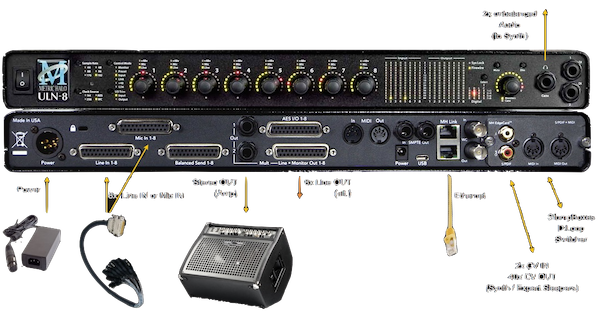 I 'll try to illustrate how flexible the interfaces are in real life with this picture. While the interface is fully wired up in the studio (on all inputs and outputs), I need different cabling when I'm performing live – after all, I don't take all my gear with me. So when I remove the interface, I simply disconnect all the plugs – and reconnect them when I'm back. Almost like a dock.
I 'll try to illustrate how flexible the interfaces are in real life with this picture. While the interface is fully wired up in the studio (on all inputs and outputs), I need different cabling when I'm performing live – after all, I don't take all my gear with me. So when I remove the interface, I simply disconnect all the plugs – and reconnect them when I'm back. Almost like a dock.
If I'm playing with a stereo setup, I just need two outputs to the amp – I use the two TRS outputs for this. The line signals are sent via a D-Sub25 cable and, if I also need microphones, I have a breakout cable for this too.
For sending 40x CV (via SPDIF) to the Buchla, I use the EdgeCard with SPDIF and MIDI. MIDI I/O allows me to travel without any MIDI interface and still connect all of my MIDI devices.
Metric Halo ULN-8 Mk IV Upgrade (2023)
Differences between ULN-8 Mk IV and ULN-8 3d: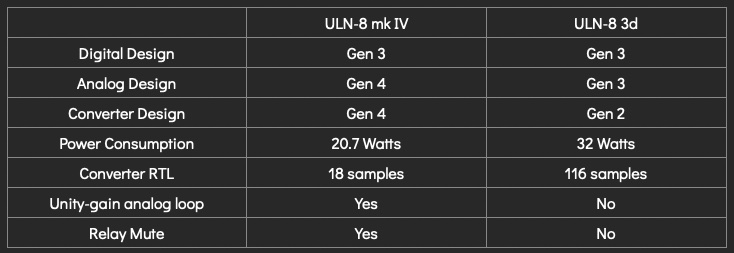
1. New analogue and converter design with even greater detail, ‘more body and soul’
2. Significant reduction in round-trip latency (RTL) for converters
3. Optimised for low-latency analogue unity gain loops
4. Relay-based output muting system for click- and pop-free switching cycles
5. 35% less power consumption – the device runs cooler (which should also protect the components)
 Again, an upgrade that lives up to its name! For me, of course, the reduction in round-trip latency is the key factor, because I use ‘real-time live electronics’ and 18 samples of round-trip latency means a latency of only 0.19 ms – that corresponds to a listening distance of 6 cm! Compared to the acoustic conditions on a stage, this means that the sound of an instrument playing 3 metres away from me takes 50 times longer to travel towards me.
Again, an upgrade that lives up to its name! For me, of course, the reduction in round-trip latency is the key factor, because I use ‘real-time live electronics’ and 18 samples of round-trip latency means a latency of only 0.19 ms – that corresponds to a listening distance of 6 cm! Compared to the acoustic conditions on a stage, this means that the sound of an instrument playing 3 metres away from me takes 50 times longer to travel towards me.
One of the welcome side effects is that this has to do with the new converters, and I welcome them just as much as all the other hardware improvements.
 There have also been some changes (improvements!) to the plug-in features (for all 3D interfaces). Not only has the new generation of MIO plug-ins become part of ‘MioConsole3d’, but several new plug-ins have also been added. Many of the plug-ins now also have visual support, which comes from the ‘Spectra Foo’ analysis software (see below). A whole new set of plug-ins from ‘Make Believe Studios’ has also been added and these are very intuitive to use. However, the real highlight for me is the Sontec MES-432 D9D, a digital replica of what is perhaps the most sought-after analogue mastering EQ in history. A new technology developed by Metric Halo has been used to implement the Sontec EQ, and in addition to Make Believe Studios, even Burgess Macneal, the inventor of Sontec, was involved in the development of the plug-in. With the upgrade to V2, an options panel has even been added as an extension, which can be used to switch the individual bands on and off and activate a mid-side function, among other things.
There have also been some changes (improvements!) to the plug-in features (for all 3D interfaces). Not only has the new generation of MIO plug-ins become part of ‘MioConsole3d’, but several new plug-ins have also been added. Many of the plug-ins now also have visual support, which comes from the ‘Spectra Foo’ analysis software (see below). A whole new set of plug-ins from ‘Make Believe Studios’ has also been added and these are very intuitive to use. However, the real highlight for me is the Sontec MES-432 D9D, a digital replica of what is perhaps the most sought-after analogue mastering EQ in history. A new technology developed by Metric Halo has been used to implement the Sontec EQ, and in addition to Make Believe Studios, even Burgess Macneal, the inventor of Sontec, was involved in the development of the plug-in. With the upgrade to V2, an options panel has even been added as an extension, which can be used to switch the individual bands on and off and activate a mid-side function, among other things.
Truly amazing! More and more hardware has to compete with this interface.
Other manufacturers are releasing new interfaces – Metric Halo is looking after its customers with hardware upgrades! Brilliant! A big thumbs up!
At $999, the upgrade isn't exactly cheap, but for a complete set of new converters of this quality, it's a very good deal—and after all, Metric Halo doesn't ask us to buy a completely new device for several thousand euros every couple of years! So: everything's fine—in fact, it's very, very, very good.!
My experience with this company and its products is without any comparison! I was one of their first customers about 25 years ago. Metric Halo has been excellently represented in Germany for several years now by Anne Goerth and Stefan Bahr, and these audio interfaces are and remain a true masterpiece!
Metric Halo Analysis Software "SpectraFoo"

With SpectraFoo, Metric Halo also offers an analysis software that will make these devices an excellent choice for sound engineers. Spectra Foo is used for analysis in the areas of mixing, mastering, acoustic analysis, live audio, and electronics. For most users, the standard version of the software should be sufficient—there is also a complete version that can be used to calibrate auditoriums and much more.
SpectraFoo Complete features a high-resolution multitone, multinoise, sweep, and burst signal generator that runs in real time and can write the signal to a capture or to an AIFF or SDII file. The interface to the signal generator is numerical, making it very precise.
- High-resolution, distortion-free 24-bit signal generation
- Up to 9 simultaneous sine sweeps
- Generation of pink and white noise
-Burst generation
- FFT-synchronized sine wave generation
- Direct generation to audio I/O, captures, and files
Patchbays for the Sub-D25 connectors of the ULN8 and LIO-8
Mamba Patchbay
The Mamba XDB has been specially designed for the ULN-8 and LIO-8 (with D-Sub25 connectors) and is ideal for everyday use in a 19" format setup..
It offers 16 analog inputs and 8 analog outputs, as well as 8 AES-EBU IN/OUT, which are located on the rear panel on four D-Sub25 sockets. Thanks to its shallow depth and closed design, the Mamba creates space in the case for power supplies for other devices or can be installed at the rear. The Mamba is fantastic for everyday use and transport—after all, it has four D-Sub25 connectors that don't need to be disconnected every time it is transported, as D-Sub25 connectors are not designed for frequent swapping.
 Since the Mamba was designed for the ULN-8, I found it odd that the first series had combo connectors on the mic inputs—but this has since been changed, and the Mamba is now available in various versions, including XLR on the first 8 inputs.
Since the Mamba was designed for the ULN-8, I found it odd that the first series had combo connectors on the mic inputs—but this has since been changed, and the Mamba is now available in various versions, including XLR on the first 8 inputs.
Stagebox
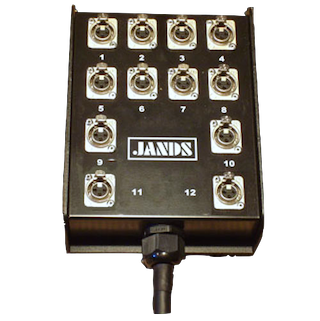 This handmade stage box with a 12-channel multicore (and two D-Sub25 connectors) is used for the 12 microphone inputs on my audio interfaces.
This handmade stage box with a 12-channel multicore (and two D-Sub25 connectors) is used for the 12 microphone inputs on my audio interfaces.
For large-scale events, I plan to use three “Audio over CAT” sub-distributors to avoid excessive cable lengths.
Audio over CAT
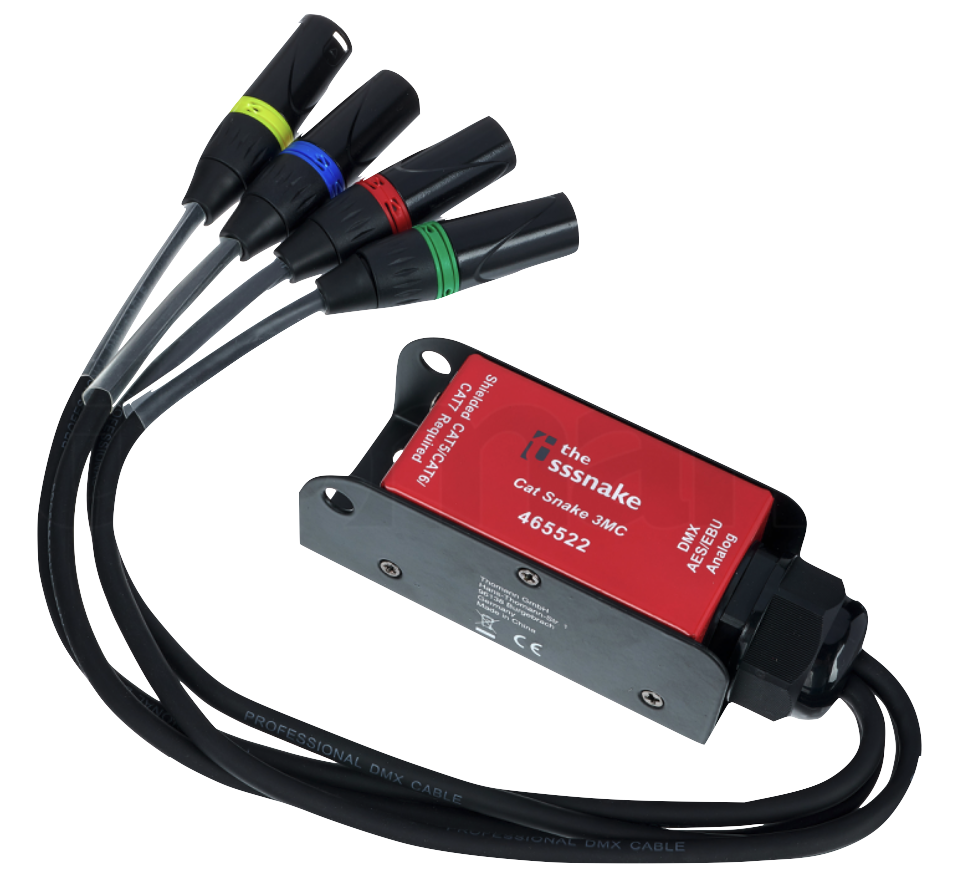 For my synths, I'm using male/female pairs of these super affordable cable splitters, which send 4 analog signals to the interface as a 4-channel multicore via a single Ethernet cable. I compared the signals with those transmitted over expensive Sommer and Mogami microphone cables and couldn't tell the difference. I still need to do a thorough microphone test, but I'm really impressed! Very easy to transport and cable-saving.
For my synths, I'm using male/female pairs of these super affordable cable splitters, which send 4 analog signals to the interface as a 4-channel multicore via a single Ethernet cable. I compared the signals with those transmitted over expensive Sommer and Mogami microphone cables and couldn't tell the difference. I still need to do a thorough microphone test, but I'm really impressed! Very easy to transport and cable-saving.
Matching Converters
Sonifex RB-BL4 and RB-UL4

In many cases DI boxes are sufficient, but in many cases they are not. Particularly with modular synthesizers, the DI boxes (or plugging the unbalanced plug into the balanced jack) deliver unsatisfying results. This is because of the rather unusual outputs of e.g. +12dB (unbalanced) or impedances of 1kΩ (1000 ohms). After trying all sorts of things with a variety of synthesizers, including expensive output modules that used transformers, the Sonifex units proved so significantly more superior that I ended up buying several over time. I started with the smaller (2-4 channel) units, but have since moved to the larger versions (19 inch, 8 channels).
Depicted are the Sonifex RB-BL4 (above), which is a bi-directional converter (4x bal. IN to unbal. OUT and 4x unbal. IN to bal. OUT) and the Sonifex RB-UL4 (below), that is an 8x (4x Stereo) balancer (8x unbal. IN to bal. OUT). Both devices combined give me 12x balancing and 4x de-balancing - plenty for my modular synthesizers. In order to get the IO's on the front, the expensive rack ears are required unfortunately, which must be bought separately.
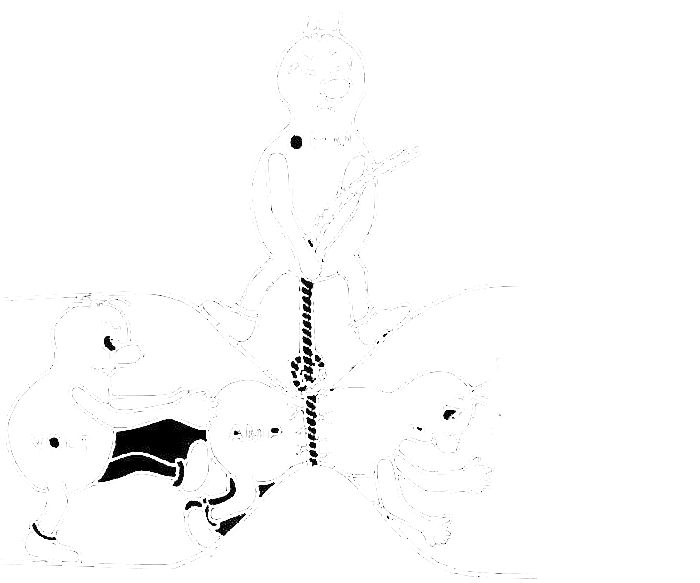 DThese devices can handle up to +28dB input - the signals are electronically transformed and delivered at less than 50 ohms.
DThese devices can handle up to +28dB input - the signals are electronically transformed and delivered at less than 50 ohms.
The Output levels will be trimmed via grub screws - that means 1x setting and forgetting.
The audio interface converters will be happy, because they would otherwise have to work against "infinite resistance".
Oh yes - Sonifex is "Broadcast Quality".
- RB-BL4 Dual Stereo Bi-Directional Matching Converter
- RB-UL4 Quad Stereo Unbalanced to Balanced Converter
Microphone- and Make-Up-Amplifier
Telefunken V 672
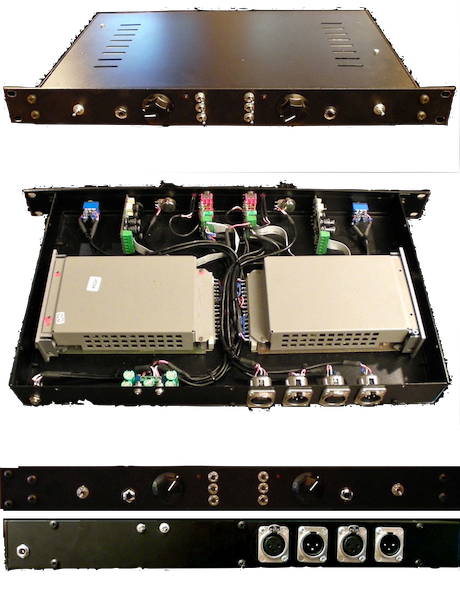
 Two “racked” Telefunken V672s (built in 1970) can be used to form either a “vintage” front or back end with up to +70dB gain. Despite their heavy weight, these old radio studio amplifiers are still a force to be reckoned with and offer excellent sound quality. It was also impressive to listen to this clean preamp in combination with a passive summing bus as a catch-up amplifier.
Two “racked” Telefunken V672s (built in 1970) can be used to form either a “vintage” front or back end with up to +70dB gain. Despite their heavy weight, these old radio studio amplifiers are still a force to be reckoned with and offer excellent sound quality. It was also impressive to listen to this clean preamp in combination with a passive summing bus as a catch-up amplifier.
The two sets of three switches in the middle (48v/Pad/Phase), the volume pot, DI input, and power supply were kits from JLM Audio, the Fet DI Kit and the Go Between Kit. However, I would like to note that the pad switch in the Go Between Kit (48v, Pad, Phase) is located ahead of the transformer and is therefore not recommended, as it has a negative effect on noise performance and sound. My 19" Stereo V672 therefore also has additional external pad switches (blue on the inside), but behind the transformer.
 The solid quality of the Telefunken V672 was truly surprising to me! Such a discrete amplifier creates a completely different kind of “body” than modern IC designs or even digital amplifiers. But there is no coloration to speak of – the amp is very clean and sounds full. After all, the Telefunken V672 was developed in 1958 for the NWDR radio studio in Bremen. It's not just a microphone preamplifier, but was designed to perform various functions, which can be switched via the connection strip.
The solid quality of the Telefunken V672 was truly surprising to me! Such a discrete amplifier creates a completely different kind of “body” than modern IC designs or even digital amplifiers. But there is no coloration to speak of – the amp is very clean and sounds full. After all, the Telefunken V672 was developed in 1958 for the NWDR radio studio in Bremen. It's not just a microphone preamplifier, but was designed to perform various functions, which can be switched via the connection strip.

I (unfortunately) rarely use the preamp anymore, e.g. when I need more than 12 microphones, then as mic preamps 5 and 6 on the LIO-8 (which has 4 mic preamps).
Primary Source Enhancer - for the concert stage:
Rupert Neve Designs Portico 5045

The Portico 5045, a secret weapon for the stage from Rupert Neve Designs. A feedback killer that can boost two microphone signals by up to 20dB before feedback sets in, without negatively affecting the source signal. It detects when signals enter the microphone and reduces the volume when it goes silent. Remarkably, the 5045 does not use any filters or digital technology for this task. However, it does feature Rupert Neve's excellent transformers, which reproduce the signal (and make it surprisingly heavy despite its small size).
There are so many unintentional encounters with feedback in live electronics that the 5045 is a true asset up your sleeve. This unit is particularly beneficial for church acoustics or stage monitors, among other scenarios. In fact, the sound even experiences a kind of refinement due to the transformers. Feedback problems belong to the past with the Portico 5045.
Analog Post-Processing - Consoles and Analog Processors
So far, we've been talking about the core equipment—the stuff you need in any case, even when performing live. It's sufficient for sound reinforcement and recording, and the equipment mentioned so far is actually more than enough to handle everything from A to Z (digitally). But, just like with synthesizers, analog devices are simply more fun to work with. The end result may be almost indistinguishable, but when you're working, it makes a world of difference. So you could argue about whether it's necessary—I hear there are even people who are willing to forego any enjoyment in order to achieve a good result.
Consoles
What I was missing in my summing buses and amps (Dangerous 2-Bus LT, D-Box, and RMS216 Folcrom) was the ability to edit individual tracks with analog gear. The much-touted “console sound” didn't come across with the summing mixers either – both of these things actually only came with the Studer console. I mainly use the console for mastering – of course, it's also my first choice for recording (when mobility isn't a priority).
Studer 961
A STUDER 961 mixing console (built between 1985 and 1989), the smallest version of the 960 series. A very special gem in my studio. Analog tracking on the individual tracks finally removes the restriction of processing just the sum in analog mode. Studer 96x consoles are still among the best-sounding consoles in the world today!

My 961 performs as an analog summing mixer, which also provides the input and output for the analog mastering chain. Its design (with transformers) can be used to achieve a specific analog character for the material in tracking. The console's outstanding sound is “clean.” The inserts in each channel strip allow you to loop in special processors or place the transfer console as a mastering chain in the master channel strips—or perhaps behind them.
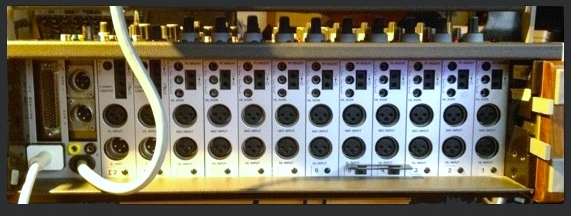 My 961 is configured as 10/2 I/O, the master faders have been removed, and the outputs have been calibrated to Unity. This modification makes it ideal for post-production and/or mastering in conjunction with digital audio interfaces.
My 961 is configured as 10/2 I/O, the master faders have been removed, and the outputs have been calibrated to Unity. This modification makes it ideal for post-production and/or mastering in conjunction with digital audio interfaces.
The internal equalizer and compressor/limiter on the 961 sound excellent. External processors in the channel inserts can make further changes to the character. Tracks or sub-groups can be processed separately (once again) in analog before being added to the sum. I connected the aux paths to the audio interface so that I can integrate AU/VST plug-ins or the MIOConsole3d plug-ins and route them to channels 9 and 10—ideal for looping in effects.
The Operating- and Service Manual in the first link provides much more detailed technical information and answers to almost every question.
- The comprehensive Studer 961 / 962 Operating- and Service Manual
- The STUDER and Revox Info Portal including historical sales brochure
Transfer Console
SPL MasterBay S
 SPL's MasterBay S is perhaps the most minimized transfer console on the market - or rather, a torso transfer console. It is completely transparent/inaudible, can be easily connected between the Mix-Buss patch points of a console and then provides this buss with its architecture.
SPL's MasterBay S is perhaps the most minimized transfer console on the market - or rather, a torso transfer console. It is completely transparent/inaudible, can be easily connected between the Mix-Buss patch points of a console and then provides this buss with its architecture.
Most helpful "little trimmings": Input and insert trimmers, swap function for inserts 2/3, master fader, volume compensation, daw return and a bypass that can be turned into an interval circuit. For inserts 1+2 or 1+3 there is a Parallel Mix blend, Insert 4 is behind it (e.g. for limiting). All functions can be bypassed via relay circuits. The Rec-Out is doubled by the Monitor-Out and there is an extra output for Metering. This unit improves the "workflow" significantly and helps me to solve 95% of all typical issues when chaining Outboard Processors.
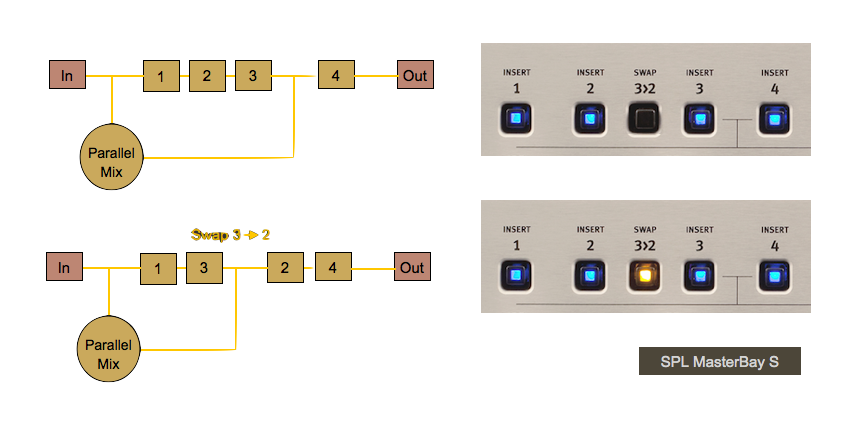 The specific features of the Swap Inserts and the Parallel Mix on the MasterBay S are often communicated incorrectly and subsequently discussed as a weakness. It concerns the fact that the inserts 1 to 3 supposedly always run together into the parallel mix. What is correct is that when the Swap function is activated, Insert 2 is taken out of the Parallel Mix. This means that two of the four inserts will be in the parallel mix - besides the first one, it's either the second or the third one.
The specific features of the Swap Inserts and the Parallel Mix on the MasterBay S are often communicated incorrectly and subsequently discussed as a weakness. It concerns the fact that the inserts 1 to 3 supposedly always run together into the parallel mix. What is correct is that when the Swap function is activated, Insert 2 is taken out of the Parallel Mix. This means that two of the four inserts will be in the parallel mix - besides the first one, it's either the second or the third one.
For me it's just perfect, because all that is missing in contrast to big transfer consoles is in my RND Master Buss Processor (see below). It is by its own parallel buss just ideally suited for the Insert2 of the MasterBay. By "swapping" behind Insert1+3 and the parallel mix, it creates a second Parallel Buss in the setup, which can be used to mix the Parallel Compression with other components than the Parallel Mix of the EQs..
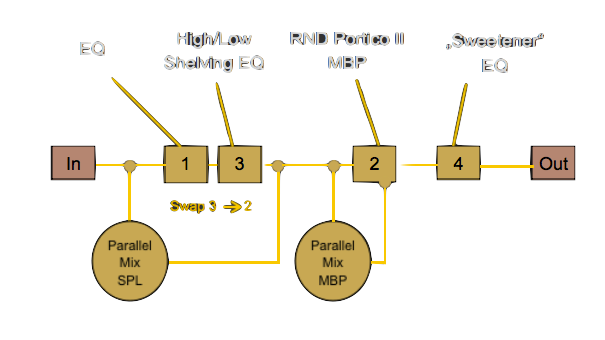 Thus, if you have a "normal" Compressor (and the Masterbay), you might consider buying an additional Parallel Blender (e.g. TK-Mini Blender or Aveson Blend) for the MasterBay S to get this range of functionality - financially it would still be far away from the prices for a full-fledged transfer console.
Thus, if you have a "normal" Compressor (and the Masterbay), you might consider buying an additional Parallel Blender (e.g. TK-Mini Blender or Aveson Blend) for the MasterBay S to get this range of functionality - financially it would still be far away from the prices for a full-fledged transfer console.
The one thing the MasterBay S lacks compared to large transfer consoles is a Mid/Side function and Width/Depth controls with filters. With the RND Mastering Buss Processor (see below) I have an excellent Width/Depth control with filters and I can achieve M/S operations with the ULN-8 or LIO-8.
Analog Peak-Meter RTW 1108
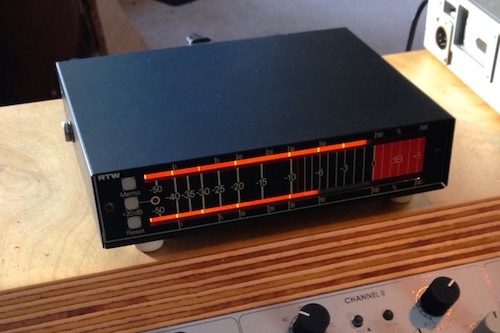 At the "metering" outputs of the SPL MasterBay S I connected an (already older) analog RTW 1108 Peakmeter. It's an RTW1108 in an 1120 enclosure, and it makes a significant improvement to the setup, partly because it allows the Masterbay's loudness compensation to be adjusted very precisely, and the transfer console to get its own display. Since it is an analog meter, the unit needs to be calibrated once every few years. I have summarized the trimmer calibration routines for the RTW1108 in a MAX patch, just in case.
At the "metering" outputs of the SPL MasterBay S I connected an (already older) analog RTW 1108 Peakmeter. It's an RTW1108 in an 1120 enclosure, and it makes a significant improvement to the setup, partly because it allows the Masterbay's loudness compensation to be adjusted very precisely, and the transfer console to get its own display. Since it is an analog meter, the unit needs to be calibrated once every few years. I have summarized the trimmer calibration routines for the RTW1108 in a MAX patch, just in case.
These vintage devices from RTW are occasionally available (used) for €100.- to 200.- (analog or digital). But they are pure peak meters with memory function (for the highest peak) - and they are available in a confusing number of variations! Therefore you need to check before buying, if it is the right and desired Meter.
Unfortunately, there is little info on the net. Here is a PDF of the successor model:
Analog Processors at the Transfer Console
Great River Electronics MAQ-2NV
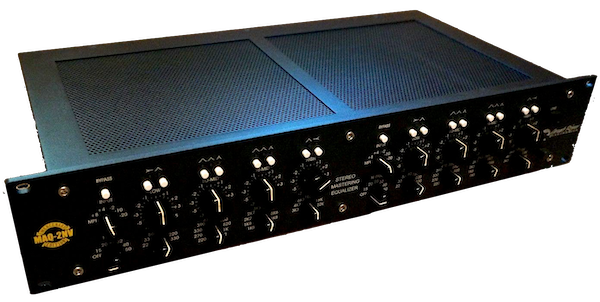 The MAQ-2NV by Great River Electronics is a modification of the popular EQ-2NV, which was implemented under the label of the (unfortunately closed) dealer "Mercenary Audio" in Boston. The modifications were based on requests from many audio engineers to use the EQ-2NV in mastering as well. Therefore, input gain, "gridded pots" (=switches), a link function for simplified stereo operation, altered, respectively extended corner frequencies, lower boost/cut values and transformers with less coloration were selected. Due to the low boost and cut values, the equalizer is therefore no longer to be used for surgical treatments.
The MAQ-2NV by Great River Electronics is a modification of the popular EQ-2NV, which was implemented under the label of the (unfortunately closed) dealer "Mercenary Audio" in Boston. The modifications were based on requests from many audio engineers to use the EQ-2NV in mastering as well. Therefore, input gain, "gridded pots" (=switches), a link function for simplified stereo operation, altered, respectively extended corner frequencies, lower boost/cut values and transformers with less coloration were selected. Due to the low boost and cut values, the equalizer is therefore no longer to be used for surgical treatments.
A striking feature are its additional unbalanced outputs and patch I/O jacks, which can be used to loop in a compressor, for example. At high input levels it can sound really dark. A strong character.
The MAQ-2NV is an extremely versatile EQ with strengths in the midrange and treble and especially in the general sound - it sounds big and pretty great. An unobtrusive giant sounding different than it looks. Its versatility is evident in how many musical genres this EQ can confront without being alienating. Technically, it carries much of the DNA of the legendary Neve 1081 EQ.
Although the MAQ-2NV at 2U is twice the size of the outgoing model - its modest appearance seems to me to be the main reason why there is so little hype about this EQ. In the "mastering scene", 4- or 5U units with extra-large knobs are simply more popular - as silly as that sounds (and I'm sure it is). There are hardly any reviews, tests or reports of the MAQ-2NV to be found. But those that do say something speak highly of this EQ. The understanding of this situation is further complicated by the fact that the MAQ-2NV is at least 1/3 cheaper than any of its, from my point of view, direct competitors.
Dangerous Music BAX
 The Bax EQ is barely audible, but everything sounds better. For me, it is usually the last EQ in the analog mastering chain. The bass is powerful, clear, clean and completely without boom, the treble is simply fantastic! It cleans up the bottom - and makes up the top, gives body, space and "expensive" transparency - also the stereo image seems noticeably tidier.
The Bax EQ is barely audible, but everything sounds better. For me, it is usually the last EQ in the analog mastering chain. The bass is powerful, clear, clean and completely without boom, the treble is simply fantastic! It cleans up the bottom - and makes up the top, gives body, space and "expensive" transparency - also the stereo image seems noticeably tidier.
You will especially notice this EQ at the moment the "Bypass" is activated. This EQ seems more like a virtuoso hi-fi loudness knob than an EQ. It has two "Baxandall" cow tail curves, as well as low and high cut filters. There is similarly little that can be said about this EQ as it has parameters. But after auditioning it, no questions are left unanswered, and it becomes clear why the Bax is found in so many mastering studios.
If you are on a budget, the Bax is worth considering as a mastering EQ - especially when coupled with a midrange EQ (like The Pullet), very convincing results can be achieved.
Rupert Neve Designs - Portico II Master Buss Processor
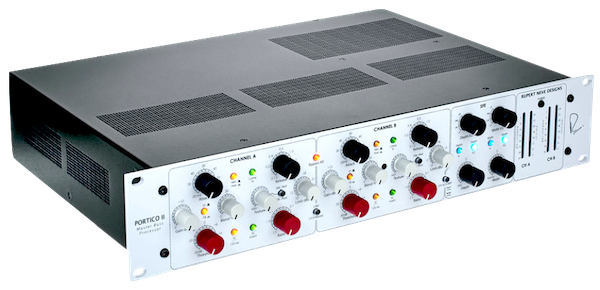 The Portico II Master Buss Processor is Compressor, Limiter, Stereo Width & Depth Editor incl. "EQ" (Filter), integrated into a bus with parallel processing and saturation blend - with four LED meters for compression and master volume.
The Portico II Master Buss Processor is Compressor, Limiter, Stereo Width & Depth Editor incl. "EQ" (Filter), integrated into a bus with parallel processing and saturation blend - with four LED meters for compression and master volume.
The MBP provides extra high currents (72V/±36V). "Huge" transformers provide excellent dynamics and impulse response. Also, Sidechain I/O's are included.The Stereo Field Editor has a longitudinal and a transverse axis, each with switchable EQ (2 bands), against Phase problems, or for M/S Compression (SFE to Comp button). An excellent Limiter - truly amazing - features only one knob and works remarkably well without being noticeable. The Neve signature Blue and/or Red-Silk circuitry is magical and really gives the sound a "shine" of its own.
This processor alone may already pass for a simple "Master Buss" because it provides the crucial tools and gives off a very solid analog fingerprint - some call it "three-dimensional". Perhaps it's just the kind of "console sound" that so many had been looking for in the summing. The integrated Compressor, as well as the Limiter, are truly impressive: you can't hear them working (but in fact, the MBP can be steplessly adjusted all the way up to "brutal"!). A Buss with own Parallel-Blend and Compressor, Limiter and Stereo-Field-Editor is moreover a super idea! Prior to my Studer console, the MBP was the biggest step towards the desired "console sound" - technically, this processor is a giant. The MBP greatly alters the incoming signals (for the better) without making you actively aware of the components involved. Incredible! A true Masterpiece.
Despite its weight, I used the RND MBP in a live setup (together with the RND Portico 5045 and the D-Box) on my NEXP PS8 PA. It revealed what the PA can do and really made it sound, An adventure!
For me, this processor was a lucky pick - and Rupert Neve has always had a knack for compressors. Fantastic! The Master Buss Processor is one of my all-time favorites! It would be the last analog processor I would hand over again.
Digital Processors
Weiss EQ1-DYN-LP
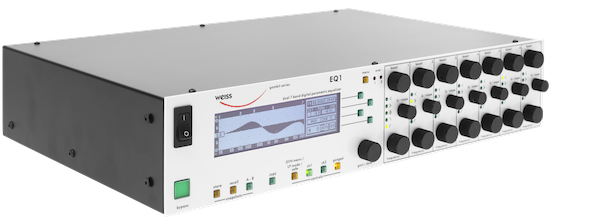 The Weiss EQ1-DYN-LP is (or was) probably the most widely used equalizer in the world's leading mastering studios. Many engineers regard it as a kind of " benchmark " and insist on this precision tool. Its reputation is legendary, as is the reputation of the Weiss company as a whole.
The Weiss EQ1-DYN-LP is (or was) probably the most widely used equalizer in the world's leading mastering studios. Many engineers regard it as a kind of " benchmark " and insist on this precision tool. Its reputation is legendary, as is the reputation of the Weiss company as a whole.
The 7-band equalizer has no converters and comes with only digital IO's - therefore it has a special place in the setup (in the virtual console). My version of this equalizer is the DYN-LP version - this is the maximum expansion stage and means that it can be started in different modes: as a dynamic equalizer (not dissimilar in behavior to a compressor) or in Linear Phase Mode - probably unsurpassed in this discipline, especially for surgical procedures. In LP mode the maximum slope of the cut filters doubles to 24dB.
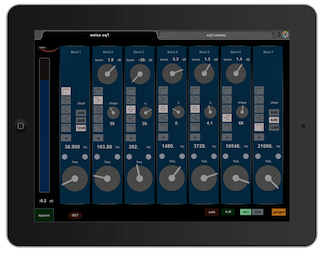 The merits of this processor also include its good user interface - thanks to its digital nature, it offers many efficiency-related benefits. Nevertheless, to get acquainted with it, I programmed a small editor for myself, which allows much faster input (no "stepping" and less twiddling of the MIDI encoders on the device) - after all, the EQ1 understands MIDI. On the right you can see an iPad screenshot of my editor.
The merits of this processor also include its good user interface - thanks to its digital nature, it offers many efficiency-related benefits. Nevertheless, to get acquainted with it, I programmed a small editor for myself, which allows much faster input (no "stepping" and less twiddling of the MIDI encoders on the device) - after all, the EQ1 understands MIDI. On the right you can see an iPad screenshot of my editor.
It's hard to convey verbally, but unlike analog equalizers (IIR/Infinite Impulse Response), this EQ does not use phase shifting. This and the extreme Q values make it possible to precisely prepare or repair the material (e.g. with hairline notches). The Weiss EQ1 is just so unagitated and sovereign - there is not any of that "build-up" of curves (even in the cut). With this equalizer, it's like cleaning up the universe and rearranging it! For mastering I use it ( as the last device) also in zero position, because the Weiss EQ1 works internally with up- and downsampling. The result sounds distinctly better. When transferring old DAT cassettes, I noticed the significantly better sound in relation to the recordings transferred directly into the ULN-8. Madness! Everything in Weiss order.
Room-Simulation
Quantec Yardstick 2496
 The Quantec Yardstick 2496 is a Room Simulator, not a Reverb. The favorite reverb of many reverb haters. A unique device - especially where reverb is not needed or does not work well, but the room is not quite right.
The Quantec Yardstick 2496 is a Room Simulator, not a Reverb. The favorite reverb of many reverb haters. A unique device - especially where reverb is not needed or does not work well, but the room is not quite right.
Quantec takes a different approach than “the others” and stands out from the crowd with its unique concept. The Yardstick 2496 has 2 inputs and 6 outputs (surround). It only has one algorithm and no converters, therefore it has digital I/O only (in AES format). Since firmware 3.x, the Yardstick is editable and manageable via a web browser.
I chose the Yardstick because in audio production, modulated early reflections (in “standard” FX reverbs) can significantly compromise transparency. Additionally, the unit is only a few inches deep, and I already possessed the ideal converters to optimize the Yardstick’s sound with my MH Audio interfaces. Especially in productions with acoustic instruments without effects, Quantec processors have been a big name for over 30 years and teach us to distinguish between modulated reverb and phase-neutral room simulation! Even after years of daily use, it's still fascinating—a device you can't hear but can clearly perceive. Another positive feature is how easily percussive sounds can be transformed into new spaces – with “normal” reverbs, this is a destructive undertaking.
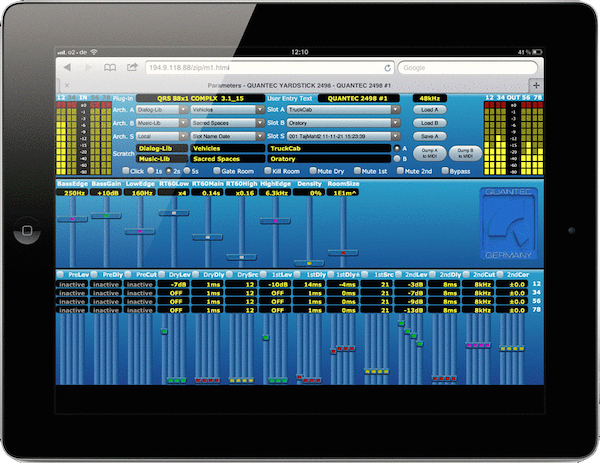
No other device or plug-in can create these spaces. Amazing.
The Quantec's room simulation is always an impressive work of art!
For me, the Yardstick has become irreplaceable.
After the early death of its inventor, Wolf Buchleitner, the company temporarily disappeared. Fortunately, a Quantec Yardstick model is now available again. It is called Yardstick 2406 S and, apart from the color, looks very similar to the Yardstick 2406—I don't know anything about possible technical changes.
Digital Metering
Clarity M Stereo
 For Mastering at the latest, a good graphical representation of the Metering is very helpful, if not necessary. Metering includes not only loudness (and peaks), but also phase correlation, mono compatibility, field distribution and spectral measurement.
For Mastering at the latest, a good graphical representation of the Metering is very helpful, if not necessary. Metering includes not only loudness (and peaks), but also phase correlation, mono compatibility, field distribution and spectral measurement.
Although some analysis PlugIns are quite nice (like Izotope's Insight 2), it's quite annoying to have them open all the time. With every new session the plug-ins have to be placed and especially if you work with only one monitor (like I do these days) you have to move the windows around all the time because they are in the way or the waveform has to be brought to the foreground - it's a miserable clicking job! The " Death Argument" (for me) is the computational resource hunger of good Analysis PlugIns. The complex graphics are much more hungry than EQ or Compressor PlugIns.
The "Clarity M Stereo" from TC-Electronic is finally an affordable Display unit - and indeed it certainly is one! It only costs €250.- (and thus less than some PlugIn solutions) and it rather creates the impression of a really solid hardware! The Clarity M offers all important displays in one spot, without consuming resources of the computer and it's absolutely great!
The views in the Clarity M can be individually configured and saved. In the spectral display, the individual bands can be "scrolled" via the encoder. Radar, VectorScope and RTA (RealTimeAnalysis) views can be switched via buttons, the radar can be started/stopped and peaks can be cleared - making the Clarity M more than just a monitor. It is also another reason not to place it somewhere in the background, but within reach - the 7' monitor is "just right": not big, but big enough. It stands very stable and doesn't create any "marks" (scratches) due to its little rubber feet. I have attached it to the free arm of my double monitor holder - so I can pull it up when needed.
The Clarity M Stereo can operate in two modes: in "Disk Mode" with a stereo digital audio input signal, and in "PlugIn Mode" via a VST, AU, or VST3 plug-in and with a USB connection. It comes with included wire whip and is capable of accepting TosLink, BNC, SPDIF, and AES connections. There even is a connector on the cable whip for a double pedal to start/stop the "radar" measurements (Ped. A) and reset the peak display (Ped. B) - these are the functions of the first two buttons. The Clarity M Stereo works in both modes (USB/PlugIn and digital audio) up to 96kHz! (This is frequently communicated incorrectly! The 48kHz limit only applies to the multi-channel model "Clarity M", not to the "Clarity M Stereo").
I clearly prefer the AES (or digital audio) mode simply because it does not require a computer connection. If the Clarity M is connected to the computer via USB in "disk mode" (i.e. digital audio mode), it mounts itself as a hard disk. Among other things, the presets can be found on it, which can also be renamed here (if desired). They can also be copied from here to another medium for backup. There are numerous useful presets, which are at least suitable as a starting point for your own presets.
A genuinely complete device! Very, very helpful! For my workflow it makes a huge difference and simply banishes a whole chunk of problems from the computer.
PlugIns
PlugIns undoubtedly have caught up significantly with hardware during the last few years. In contrast to hardware processors, they offer the advantage of being used in numerous instances at the same time. Certainly I have plug-ins from various companies, but here I would like to present just two of the companies that play an important role in my everyday life. These are the PlugIn Alliance and UAD. Both companies do have "unique proposition features" - UAD was probably the first company that could convince with emulations of existing (historical) hardware and PlugIn Alliance has the TMT circuit (Tolerance Modeling Technology), which creates minimal deviations between individual channels when using the same plug-ins on multiple channels, so that e.g. 10 channel strips thereby come much closer to the sound of a console, because the sum adds up richer (and PlugIn Alliance also offers busses!). Both companies sell virtualized audio processors from a similar technical range.
PlugIn Alliance
PlugIn Alliance is a very welcoming company. They are "good" to their customers, they offer regularly tempting special offers, they communicate in a pleasant way and they are interested in their customers' requests. Their PlugIn quality has improved tremendously during recent years, and the PlugIns are also at the forefront of user-friendliness. The selection of emulated processors is (for me) the most interesting on the market. I'll try to show this with just two PlugIns:
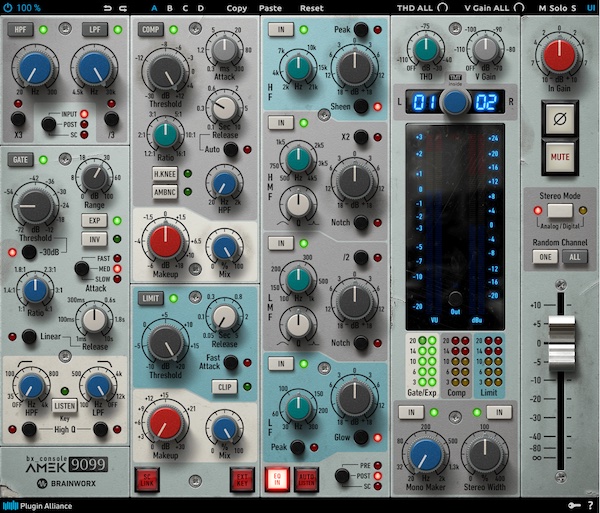
The channel strip of the Amek 9099 console, my favorite channel strip. You don't really need much more! An excellent rendition of a very rare and pricey, historic piece of hardware (with a huge history) - and there are other Amek processors in the lineup (Amek 200 and 250 EQs and Amek Mastering Compressor) which are delightful as well. Particularly with the channel strips, the in-house TMT circuitry is a benefit not to be underestimated.
However, not only emulations of historical processors exist. A recent example is the mastering EQ SPL PQ - still a fairly new EQ, which has taken off in the mastering scene, yet has "its price" as a hardware. With its 120V rail technology and many special features, SPL belongs into the top class of the mastering segment.
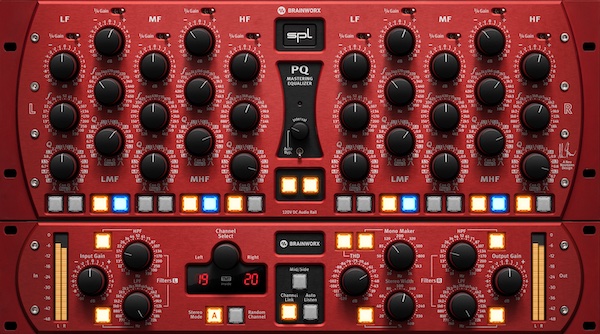
A prominent feature of the SPL PQ is the ability to toggle the Q-factor (resonance) from constant to proportional, i.e. the band of the Q-factor becomes narrower as the volume increases. This makes cuts or boosts much easier to apply and no longer a permanent destructive effect on the whole material. The SPL PQ is the first analog EQ that offers this functionality.
The lower part (the lower "device") is not part of the SPL hardware, but a "PlugIn-only feature" (which can also be turned off and hid). The module includes Tolerance Modeling Technology, Mid/Side Processing, Mono Maker, Stereo Width, THD, Auto Listen for all five bands, Filter, Gain and Metering. Brainworx (part of the PlugIn Alliance) manages to leave a very good "imprint" of its own, adding valuable enhancements to a very good processor.
The communicational delight of the PlugIn Alliance is also evident in the number of interesting contractual partners (such as SPL). The newly released PlugIns regularly generate a "relieving" joy, this thrill. Some other vendors manage that too, but they only do it once or twice. One more important thing before I get to UAD: The PlugIn Alliance PlugIn licenses can also be transferred to other accounts. This means that you can sell "used" plug-ins to other people.
I have been very well treated by the Alliance and it is the company which for me is at the forefront of the great movement towards ITB, which means away from hardware. I can only recommend them and tip my hat.
UAD
My UAD history goes back to the beginning and has developed a pale aftertaste that is becoming more and more pervasive for me and has triggered a subsequent gradual departure. In short, the company's policy is a real pain in the neck (and wallet, if you go with it). It starts with the obligation to (expensive) hardware. If you don't want a UAD audio interface, you have to get an "accelerator", the UAD Satellite. For all its "professional" looks - even in February 2023, the current Thunderbolt Satellite still has a TB3 connector, not contemporary, and you need an (ugly and expensive) TB4 adapter if you're not working with outdated computers. Inside, the issue continues - 4 or 8 totally outdated Sharc microchips are at work. When it comes to hardware upgrades, you'll have to pay a lot again - I don't remember any preferential offers for the existing customers.
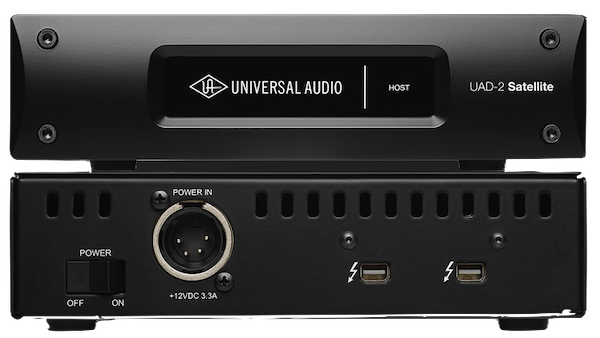
This problem runs through the entire hardware area of the company, and it comes still worse, because even after the purchase of the PlugIns the paternalism by the company will remain. You are not allowed to resell the plug-ins individually, but only your entire account, i.e. either all plug-ins or none. One does not have to calculate for a long time to find out that enormous financial losses are to be scheduled when selling the PlugIns. The PlugIns are pretty expensive and the bundle offers, e.g. 3 PlugIns for € 699.- do not tear me out of my chair.
Therefore, the longer you are " with it ", the larger the quantity ( crowd ) of the PlugIns, which occupy space in the computer and become rotten. That's thousands of Dollars that disappear from the financial circulation of the studio! Everybody knows this: to finance new equipment, you need to resell older equipment. It's just the same like with cars. This UA pseudo-exclusivity gives me a feeling of being blackmailed.
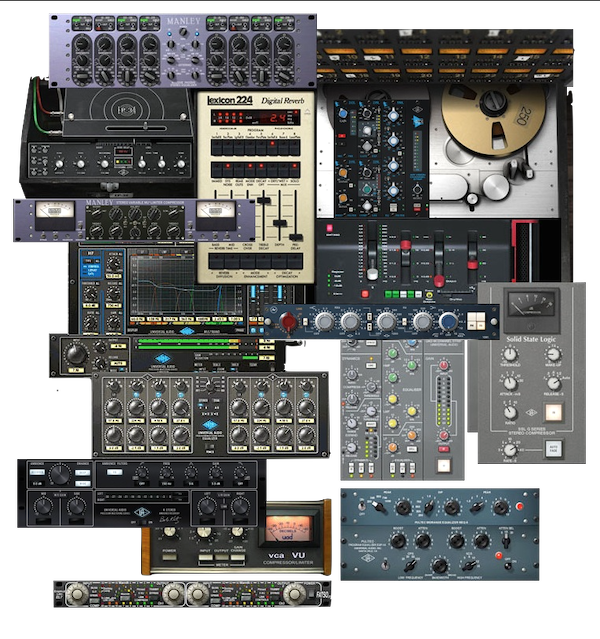
I haven't bought additional plug-ins for a while now, but I still hold (and enjoy) my Satellite and finally I want to get to the positive aspects of it.
Especially some of the reverb PlugIns (e.g. Capitol Chambers, Ocean Way Studios or AKG BX 20) I appreciate very much. Also when it comes to tape plug-ins, UAD has been ahead of the game and there are a few personal favourites. But at the latest with the M1 chip (from the Apple point of view), the external "acceleration" is no longer necessary. It used to be a great relief, especially on Reverbs, because the computers would go on their knees quite fast. Today I would probably still buy a Satellite (preferably used) and use UAD primarily as a reverberation device - and leave out the rest (especially the circumstances) or don't think about it any further.
Softube Weiss DS1 Mk3
 The Weiss DS1 Mk3, together with the (hardware) EQ1, forms a “digital gold plating stage” in my mastering setup. This plug-in is a “line by line” port of the code alongside other “new Weiss processors” that are only available as software. It is, so to speak, the counterpart to the EQ1. It is ideal for removing muffled sounds, streamlining, and adding transparency, brilliance, or elegance. Previously rather unaffordable due to its (hardware) price of $10,000, it is now available natively!
The Weiss DS1 Mk3, together with the (hardware) EQ1, forms a “digital gold plating stage” in my mastering setup. This plug-in is a “line by line” port of the code alongside other “new Weiss processors” that are only available as software. It is, so to speak, the counterpart to the EQ1. It is ideal for removing muffled sounds, streamlining, and adding transparency, brilliance, or elegance. Previously rather unaffordable due to its (hardware) price of $10,000, it is now available natively!
The DS1 Mk3 offers parallel compression, M/S mode, sidechain link, and allows “cross-listening” via the monitor switch, similar to the solo switch on a mixer—very helpful for finding the desired settings for M/S and sidechain operations. The plug-in also offers a real-time waveform as a helpful visualization and two limiting algorithms that primarily expand the functionality stylistically. Since Softube, the DS1 Mk3 is also suitable for loud music—the new algorithms open the doors to popular music and today's processing requirements. Both algorithms do not pump as quickly as the original algorithm and are deeper/stricter/harder.
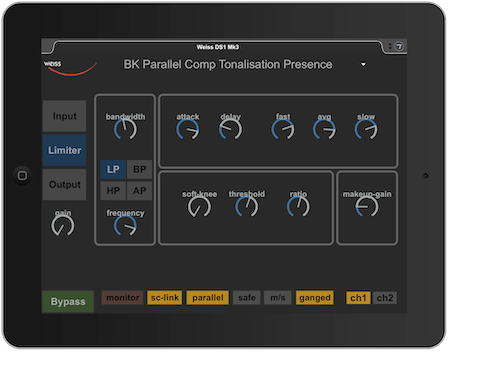 I have also built an iPad control for the DS1. Especially when mastering, I find it convenient not to have to move my head or body when adjusting settings, and the iPad minimizes the necessary movements. The software is identical to the hardware in terms of how it works and its effect. I can't say whether the sound is really identical or just the way it works. The Weiss EQ1, which I also have as hardware, creates a certain aura that the plug-in lacks (but which also has its advantages with visual aids).
I have also built an iPad control for the DS1. Especially when mastering, I find it convenient not to have to move my head or body when adjusting settings, and the iPad minimizes the necessary movements. The software is identical to the hardware in terms of how it works and its effect. I can't say whether the sound is really identical or just the way it works. The Weiss EQ1, which I also have as hardware, creates a certain aura that the plug-in lacks (but which also has its advantages with visual aids).
The DS1 is a powerful tool for pre-producing electronic music. In monitor mode in particular, you can achieve extreme filtering effects with a 24 dB filter and a maximum knee range of 70 dB. Using M/S, you can virtually turn sounds inside out with the filter.
However, one thing must be mentioned: like the hardware, neither the Softube Weiss EQ1 nor the DS1 Mk3 are suitable for tracking, as they have enormous latency (8000 samples plus buffer size). For many users, this alone might be reason enough to reject them.
Weiss Complete Collection 2
Meanwhile, I've got the Weiss Complete Collection 2 and will write more about it soon.

Elgato StreamDeck +
Stream Deck + is Audio mixer, Studio Control, Production Console
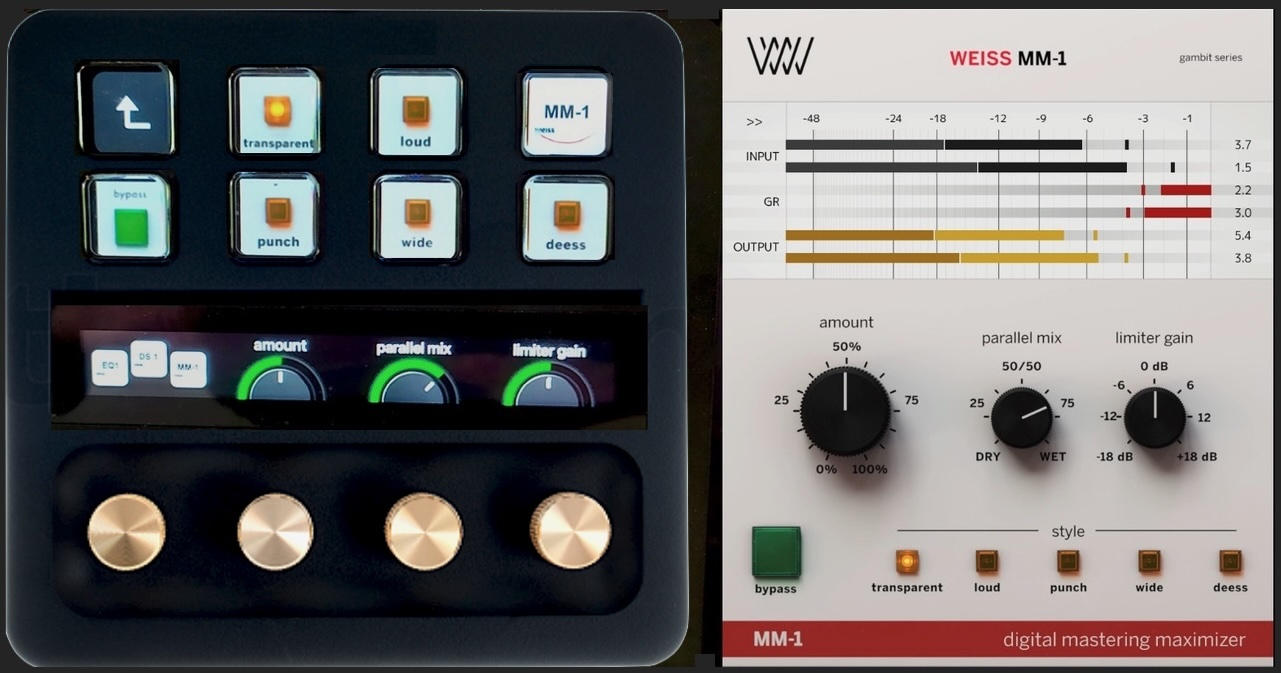 I stumbled upon Elgato's Stream Deck+ while I was programming my own ITB Mastering Bus (in MAX) and wasn't too happy with the iPad controls. The Elgato Stream Deck +: a controller with customizable LCD buttons, a touch bar, and rotary encoders with push function. I ordered it to give it a try. I quickly realized that, in my opinion, this is one of the best controllers to have been released in recent years!
I stumbled upon Elgato's Stream Deck+ while I was programming my own ITB Mastering Bus (in MAX) and wasn't too happy with the iPad controls. The Elgato Stream Deck +: a controller with customizable LCD buttons, a touch bar, and rotary encoders with push function. I ordered it to give it a try. I quickly realized that, in my opinion, this is one of the best controllers to have been released in recent years!
After the very first try, I noticed that it is vastly superior to the iPad as a controller, particularly when it comes to mastering, where the finest parameter value changes are important. The four detented endless encoders feel very similar to those of the Weiss EQ1—not quite as dignified, of course, but absolutely usable—very pleasant.
First, I programmed the controls for the MM-1, which is part of the DS1 Mk3 plug-in package—with the MM-1, all parameters even fit on one “view” of the Streamdeck+ (see image). Next followed the controls for the DS1 Mk3. After that, it was clear that this controller was here to stay.
You can create your own images for the buttons (including for the on and off states), and the touch bar is ideal for displaying the current encoder values and switching to an adjacent view by swiping. You can create as many “profiles” as you like, each of which can consist of any number of “views.” The encoders also have the additional push function. A great concept! I always keep the Stream Deck + on my computer, using it to open apps and many popular apps (such as MAX) have their own profiles. This has greatly reduced the time wasted opening programs and program files with the trackpad or mouse!
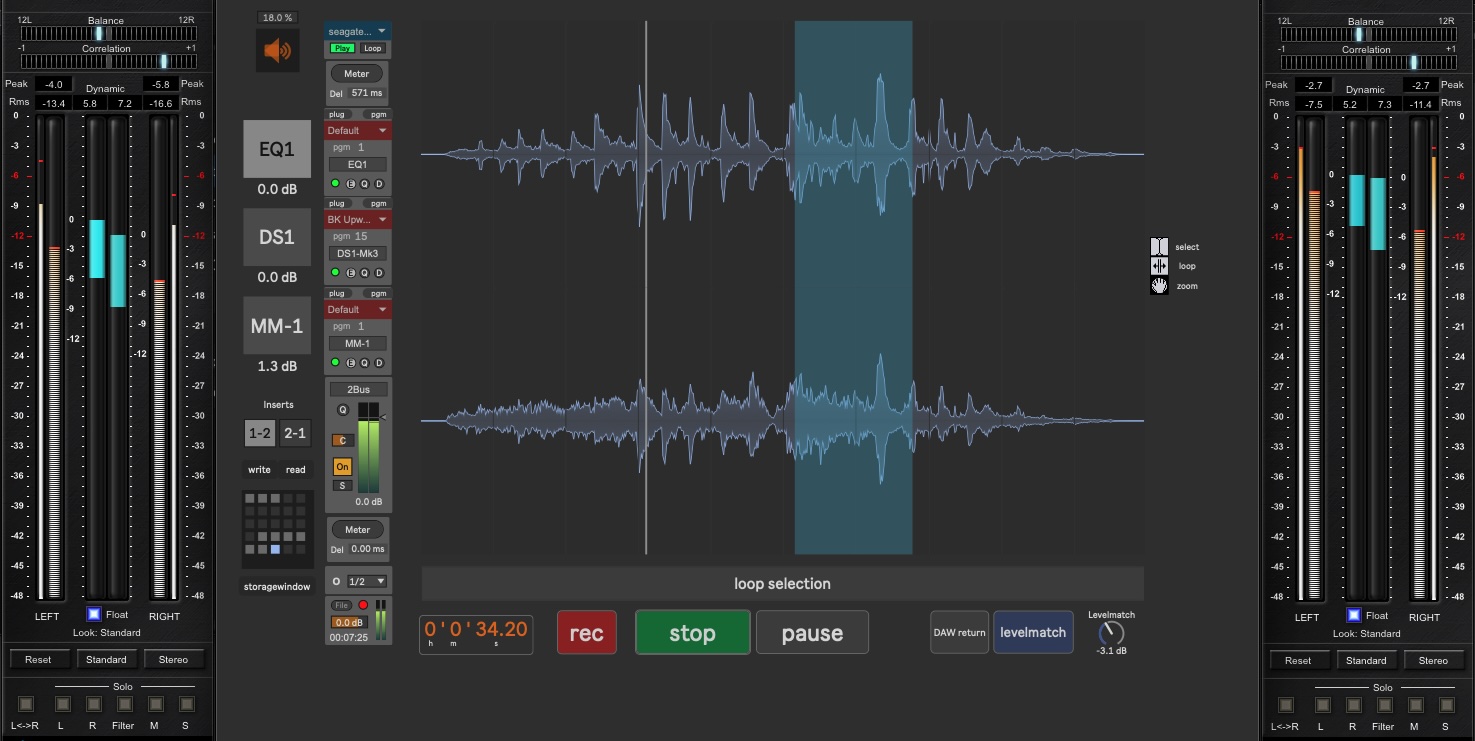 When I was about to purchase the Weiss Exiter at the introductory price, Softube offered me a very attractive deal for an upgrade to the Complete 2 Collection, which I couldn't resist. Without Stream Deck+, that might not have happened. ;-)
When I was about to purchase the Weiss Exiter at the introductory price, Softube offered me a very attractive deal for an upgrade to the Complete 2 Collection, which I couldn't resist. Without Stream Deck+, that might not have happened. ;-)
By the way, the image shows the enormous latency of 571 ms that the Weiss plug-ins have in the “Weiss Mastering Bus.” They apply to the left meter so that input and output can be viewed together during listening!
Utility
Dangerous Music D-Box
The Dangerous D-Box has proven itself to be a very high-quality and practical backend. It delivers all the things that make sense as an extension of an audio interface: speaker A/B and Mono switching, a Talkback microphone, analog and digital Stereo Inputs. Today, I use it as a “utility hardware.” Even without its summing capabilities, the D-Box’s functions are often helpful—a kind of high-end “Swiss Army knife”.
 I mostly use it on the digital inputs, i.e. as a headphone amplifier for the one or two people at the mixing console, located in the audience area or adjacent room. Since I leave my audio interfaces on stage as stage boxes (which saves a lot of cables), I can send two stereo channels to the D-Box via AES. One of the D-Box's headphone outputs could also be routed back to the stage to use the built-in talkback. With “Audio over CAT,” just one CAT5/6 cable should be enough for everything.
I mostly use it on the digital inputs, i.e. as a headphone amplifier for the one or two people at the mixing console, located in the audience area or adjacent room. Since I leave my audio interfaces on stage as stage boxes (which saves a lot of cables), I can send two stereo channels to the D-Box via AES. One of the D-Box's headphone outputs could also be routed back to the stage to use the built-in talkback. With “Audio over CAT,” just one CAT5/6 cable should be enough for everything.
One analog and two digital inputs (up to 100 kHz) with excellent converters can be used for additional listening points. Two individually adjustable, high-quality headphone outputs round off the device. In terms of technology and sound quality, the D-Box is already of a very high standard. Launching the D-Box in 2006 was a really good idea!
Since the resolution of DAW software coherence issues (around 2008), analog summing no longer holds the advantage, provided one has a good audio interface. In the beginning (2006), the term “console sound” was often used in connection with analog summing—this was more of a wish than a reality and does not quite correspond to reality. ITB summing (ITB = In The Box = digital) within the ULN-8 software console sounds “just as good” — in many cases even slightly better, because analog summing (= OTB = Out The Box) always involves the interaction of components, as it entails a change in impedances. Due to this circumstance, it is impossible to make a general statement about the quality of analog summing as such – but the D-Box is still very good as a minimal solution!
Mackie-VLZ3 Small Mixer
 Mackie mixing consoles have been with me since the 1980s. They are special because they offer extensive patching options and have a good, “solid” sound. I don't know if it's still true, but the early models could be thrown out of a window or be driven over by a car (there have been YT “test videos”). They were virtually indestructible.
Mackie mixing consoles have been with me since the 1980s. They are special because they offer extensive patching options and have a good, “solid” sound. I don't know if it's still true, but the early models could be thrown out of a window or be driven over by a car (there have been YT “test videos”). They were virtually indestructible.
For line signals (e.g., synthesizers), the console is always an acceptable solution for a submix when synths are to be combined and provided with FX, for instance.
The current model is the: • Mackie 1202VLZ4
Switchboxes
The Sub-d 25 switch boxes are available in various designs for €10-20 (see image below). They are actually intended for printers, but mine has also worked very well for my analog/digital experiments by sending the sum bus via 8-channel multicore cables to different devices for comparison. I didn't notice any negative effects on the sound! The inexpensive box is perfect for such experiments. There are also very expensive audio DB25 switchboxes, such as the “Model 8454” from ElectroStandards (also pictured, right).
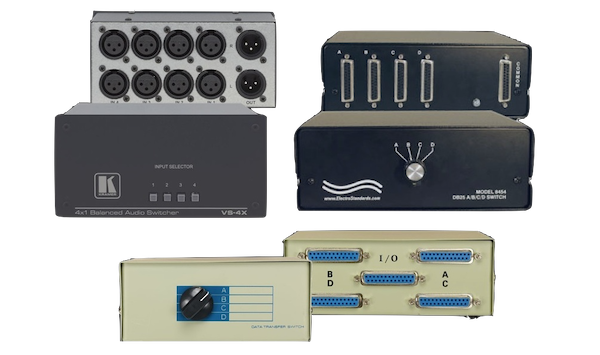 The passive input selector made by Kramer (pictured above left) is very useful and highly recommended. It allows you to choose between four balanced input sources. This input selector performed better than I had expected. I purchased it to compare the stereo output of different summing mixers.
The passive input selector made by Kramer (pictured above left) is very useful and highly recommended. It allows you to choose between four balanced input sources. This input selector performed better than I had expected. I purchased it to compare the stereo output of different summing mixers.
Generally speaking, it should be noted that not using a switchbox should always be prioritized in terms of sound quality.
Wiring in the studio
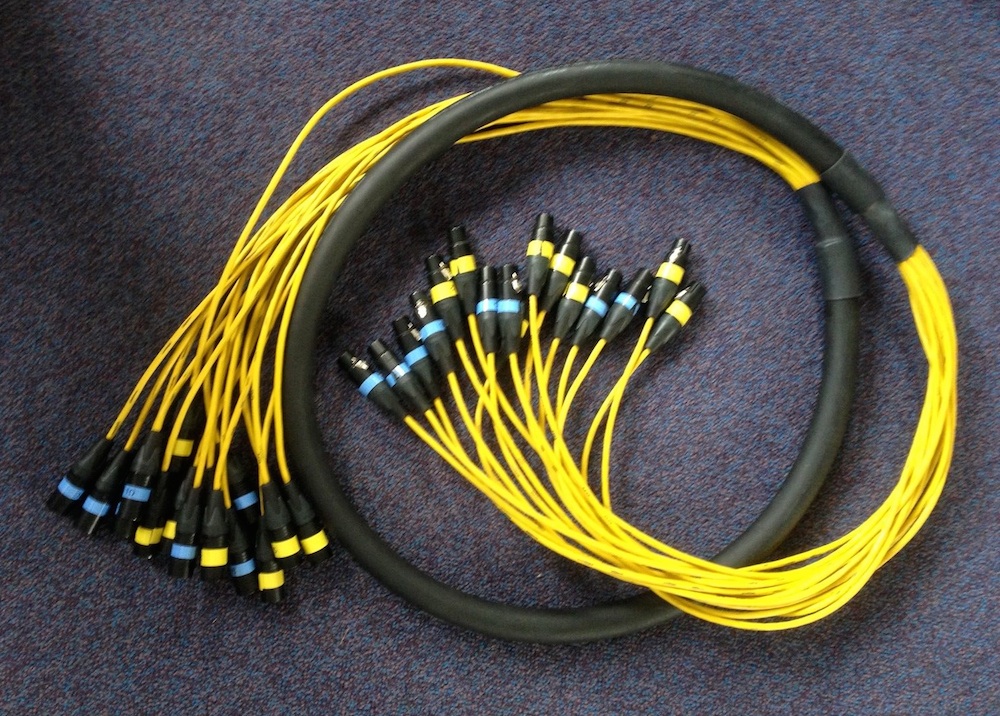 Especially in the studio (and for recordings), the quality of the wires should be as high as possible. The differences are amazing! My cables are mainly from Mogami, Sommer, Vovox and Isoda. Plugs and sockets are from Neutrik and Switchcraft.
Especially in the studio (and for recordings), the quality of the wires should be as high as possible. The differences are amazing! My cables are mainly from Mogami, Sommer, Vovox and Isoda. Plugs and sockets are from Neutrik and Switchcraft.
Unfortunately (or: fortunately) there are countless, different cables from each manufacturer and not all cables are suitable or equally good. The Vovox cables are rather too sensitive for "on the road" and also a heavy load (too heavy for me) on the bank account, so I only use them for certain microphones.
While my multicores are mostly from Mogami and the choices are not difficult, it's quite different with Sommer. By chance I got a 2m 16ch Sommer Pegasus cable (picture), which I took for the wiring of the transfer console, because I had to use the short Mogami cables, which were plugged in there, somewhere else. The surprise was great: the Pegasus cable sounded considerably better!
Amps + Speakers
Studio-Monitors
Neumann KH 310A Speakers and KH810 Subwoofer
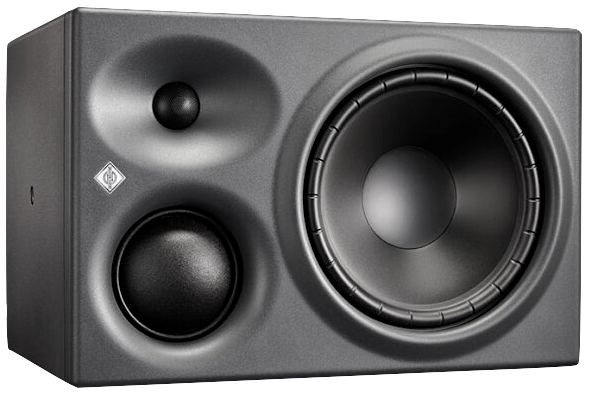 I have been working with Neumann KH 310A since the beginning of 2014 and I'm very happy with it. Amazing how everything can be heard in an unstressed manner! They provide a fantastic stereo image and allow unstrained listening!
I have been working with Neumann KH 310A since the beginning of 2014 and I'm very happy with it. Amazing how everything can be heard in an unstressed manner! They provide a fantastic stereo image and allow unstrained listening!
The enclosed design makes handling very straightforward. Due to 3-way and 34Hz lower limit, they are also very well suited for mixing without a subwoofer. True top of the line monitors! (Using a sub makes phase deviations likely, so mixing without a sub is easier, more efficient and less tiring). As an old Klein+Hummel aficionado I was at first suspicious whether the Neumann takeover was a good thing, but in this case my suspicions have since disappeared.
Utility Monitors
Tannoy 402
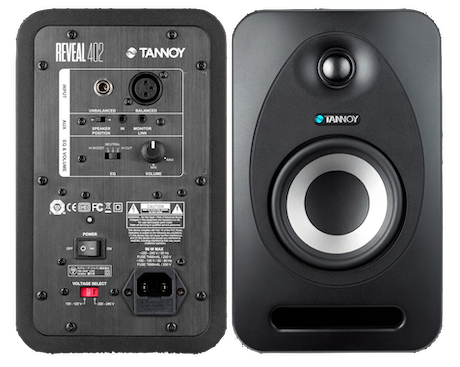 The Reveal 402 are somewhere between hi-fi box, studio monitor and computer system and are astonishing: these small speakers are really capable of reproducing all the music!
The Reveal 402 are somewhere between hi-fi box, studio monitor and computer system and are astonishing: these small speakers are really capable of reproducing all the music!
Of course, due to the compact size, both the depth and the spatiality are more imperfect than with the larger KH310A. It would also be questionable if not - but it is quite possible to work with these speakers and for me they are even suitable as B-speakers.
These speakers are especially recommended as "utility" speakers because on the rear panel, in addition to balanced and unbalanced mono inputs, there is also a stereo mini-jack input and and a monitor link output (mini-jack). The link cable is included.
I had gotten these monitors for €120.- ( special offer). In the meantime they are a bit pricier (pair: 178.-) and maybe not that competitive anymore - but they still do their job to my satisfaction even after 6 years.
For "resetting" the aural canal and for a better idea of how it may sound on "normal" equipment, I find this solution quite suitable.
PA
NEXO PS-8
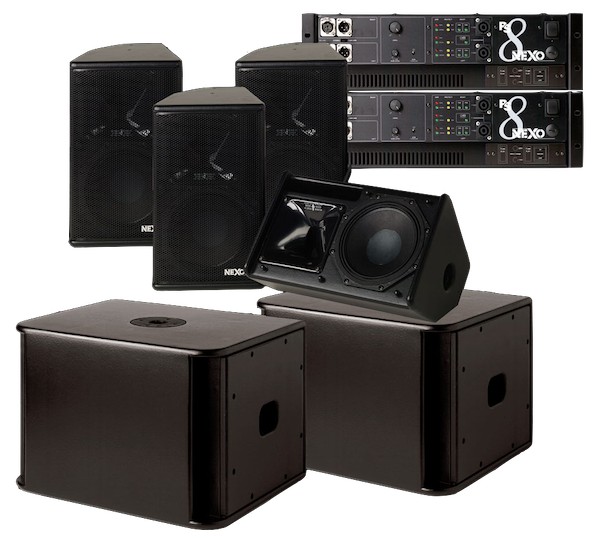 These two small PAs are a lasting pleasure for me! Their performance (coverage) and their sound image are in no way inferior to the very big names in this industry - such as MeyerSound or D+B. With the truly small PS-8, NEXO has hit the big time! The PS-8 has very clear top end and can deliver a stable, musical and balanced sound! The subwoofer can be heard quickly and early enough - this was a minor weakness of the PS-10. The NEXO PS8 is also excellent for "instrumentally amplified" live electronics in chamber music ensembles. Despite its small size, it produces an incredible 1750 watts. Most importantly: all the details are still audible even from the 12th row!
These two small PAs are a lasting pleasure for me! Their performance (coverage) and their sound image are in no way inferior to the very big names in this industry - such as MeyerSound or D+B. With the truly small PS-8, NEXO has hit the big time! The PS-8 has very clear top end and can deliver a stable, musical and balanced sound! The subwoofer can be heard quickly and early enough - this was a minor weakness of the PS-10. The NEXO PS8 is also excellent for "instrumentally amplified" live electronics in chamber music ensembles. Despite its small size, it produces an incredible 1750 watts. Most importantly: all the details are still audible even from the 12th row!
Because I also do 4-channel performances, I immediately purchased a second PS-8 PA after a short test (see picture). For extra "fat" 2-channel performances, the PAs can also run in parallel and then double the output to 3500W!
These PAs have really brought autonomy to me. Not only do they sound better, but they are not hard-wired (for an altogether different sound reinforcement "philosophy"). Everything can now be arranged by me in the way that suits the situation best. The performance of the small PAs cannot be guessed by just seeing them. You have to hear them - and you will not believe that what you hear comes from this small PA alone!
Keyboard Combo
Traynor K4
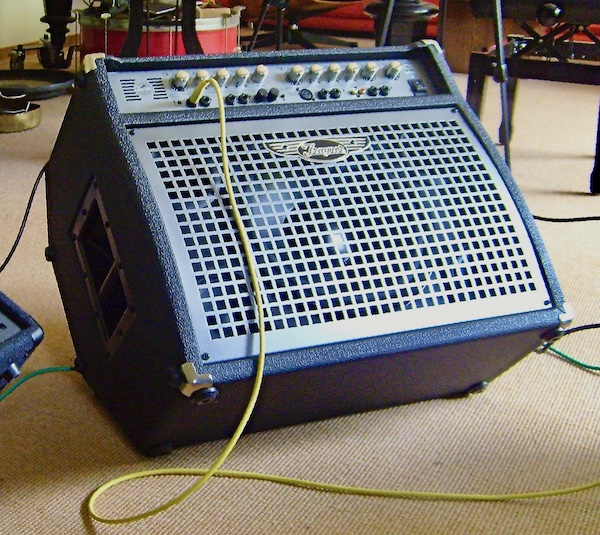 Initially only for the Fender Rhodes, I opted for the Traynor K4 combo amp (3 amplifiers, 4 stereo channels, 5 speakers), which is not very common in Europe. Assertiveness and sound are impressive. This amp is a small PA in a combo.
Initially only for the Fender Rhodes, I opted for the Traynor K4 combo amp (3 amplifiers, 4 stereo channels, 5 speakers), which is not very common in Europe. Assertiveness and sound are impressive. This amp is a small PA in a combo.
The "Ch" (channel) designations are somewhat confusing, because they are always stereo inputs (only left = mono). The Ch 1+2 ( i.e. Input 1-L+R and 2-L+R) each have a 3-band equalizer. Ch 1 is also equipped with Overdrive and Lead Level, which can also be toggled via footswitch. Ch 2 has an alternate XLR input and Ch 3 has two alternate RCA (RCA) inputs (and gain control only). Ch 4 is on the rear panel (with volume knob) and is designed for an incoming stage monitor signal. It is therefore only sent to the combo speakers, but not from the line output of the amplifier.

The very loud 300W (200W low and 2x 50W high) are not lost even on large stages. Lovers of extra low frequencies may also connect an (active) subwoofer to the dedicated outlet. The charisma of the K4 on stage is sovereign, balanced, compact and powerful. I also really like this amp for amplifying live electronics! Very sculptural and "physical". The dimensions are 60 x50 x40 cm and the weight is 23 kg.
Combo amps for keyboards/synths have always been a hassle - but not the Traynor K4. A superb amp! I was lucky enough to get the last model before the RoHs changeover. After about a year, RoHs compliant models (with a changed logo on the grille) showed up, but it became quiet about this amp. Unfortunately, it has since been discontinued. There are still Traynor Keyboard Amps (up to max. 200W), but I have no knowledge of them.

